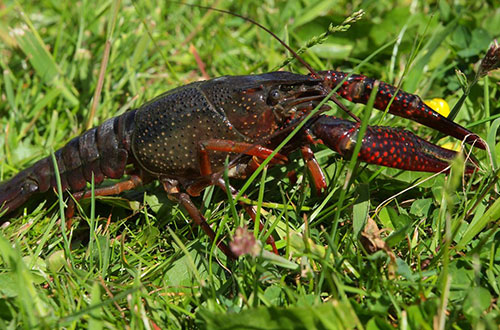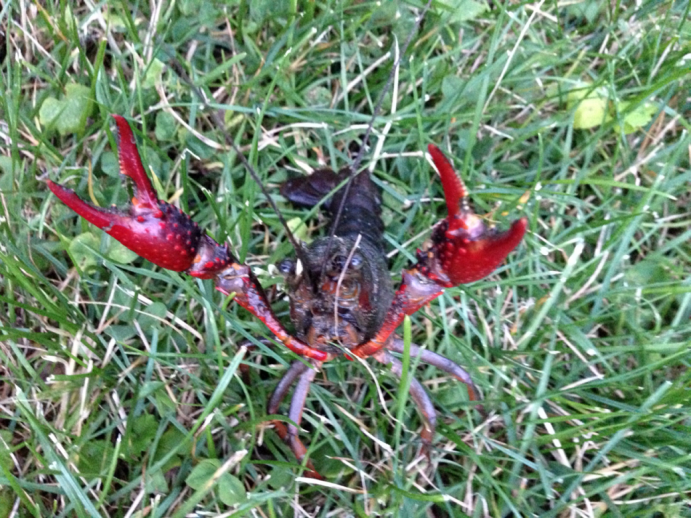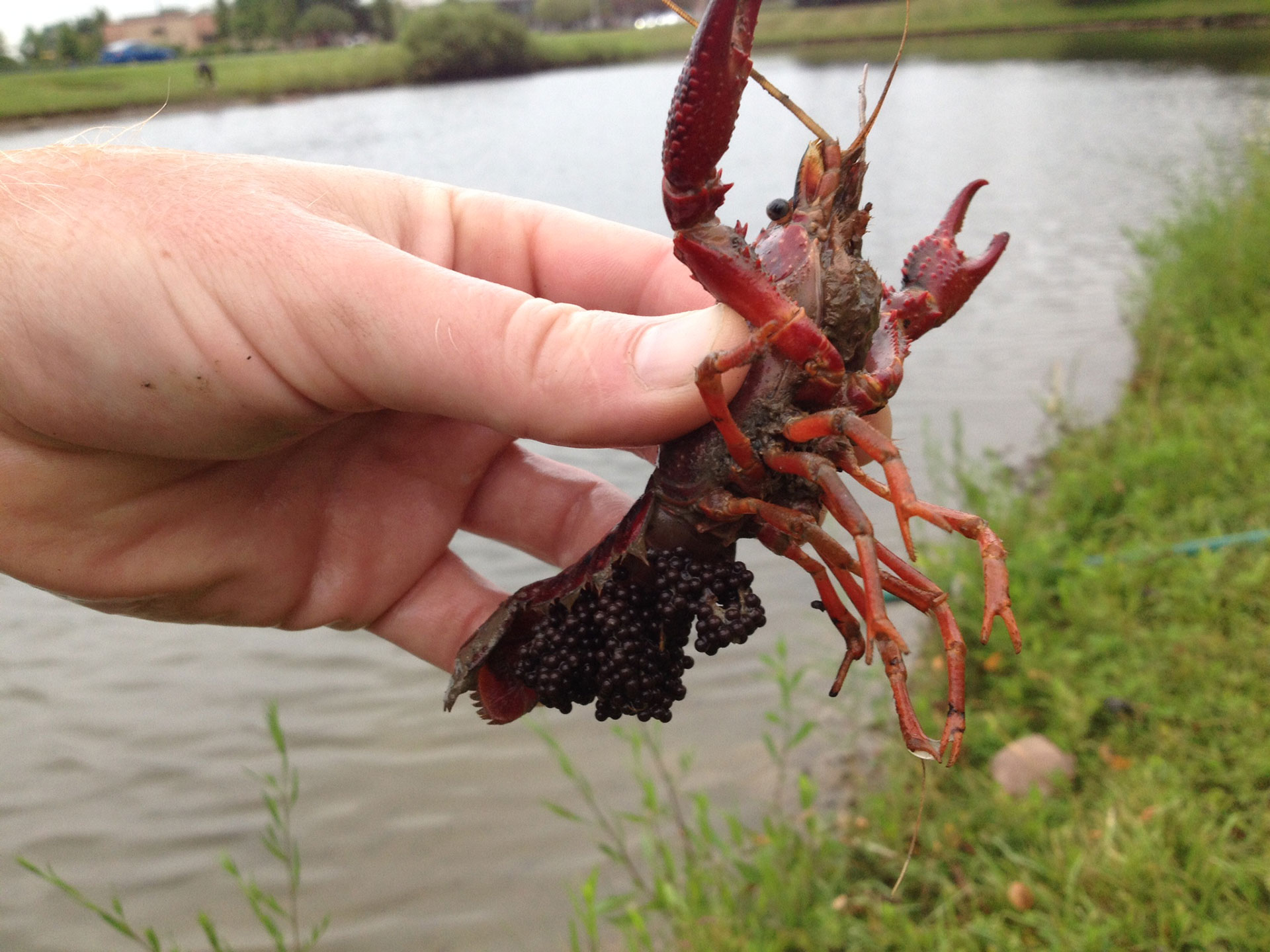In Louisiana, a heaping bucket of red swamp crayfish spells P-A-R-T-Y.
In Michigan, they spell T-R-O-U-B-L-E.
Native to the Gulf Coast, these crustaceans are a staple in Southern cooking. But far from home, these “mini-lobsters” pose a significant threat to the environment in the Great Lakes State – including to native crayfish species.
The danger is so real that it’s illegal to possess live Louisiana crayfish in Michigan.
“The species is so prolific and can cause such ecological damage that we had to put this measure in place to make sure we are protecting Michigan’s natural resources,” said Seth Herbst, Michigan Department of Natural Resources aquatic invasive species coordinator.
At two-to-five inches long, Red swamp crayfish (often referred to as crawfish in southern states) are relatively large and aggressive, often outcompeting native crayfish for food and habitat and disrupting the food chain. They can also cause economic harm by digging burrows up to 3 feet deep near lakes and rivers, damaging infrastructure such as dams, levees and personal property.
That’s why live red swamp crayfish have been prohibited in Michigan since 2015.
And yet the invaders have made their way here.

How did red swamp crayfish get here?
Live red swamp crayfish were first discovered in Michigan in July 2017.
Deep red in color with bright red, raised spots covering their body and claws, these crayfish resemble miniature lobsters. They have a black, wedge-shaped stripe on top of their abdomen and average 2 to 5 inches in length.
Red swamp crayfish can survive drought conditions and are known to migrate as far as 2 miles over land in search of food and shelter. Furthermore, females lay as many as 600 eggs at a time and reproduce up to two times a year.
Residents discovered the infestations last summer in two locations nearly 150 miles apart: Novi and Vicksburg, a village south of Kalamazoo.
“The retention pond in Novi was less than an acre in size, but we removed more than 4,000 crayfish from it from July through September,” Herbst said.
Eradicating red swamp crayfish is difficult, said Nick Popoff, DNR aquatic species and regulatory affairs manager.
And it can prove expensive.
In Wisconsin, for example, the state spent $3 million to eradicate red swamp crayfish from just a few small ponds.

Managing the invaders
The DNR uses baited crayfish traps, dip nets and electrofishing to capture and remove the crayfish. Electrofishing puts a current in the water that stuns the creatures without killing them and allows their capture.
“Throughout the state, great work is done to help manage our wildlife and natural resources – including management of invasive species such as the red swamp crayfish,” said Matt Pedigo, chair of the Michigan Wildlife Council.
The Michigan Wildlife Council was created in 2013 to increase public knowledge of the importance of wildlife management and conservation, as well as the positive impact fishing and hunting have on Michigan’s wildlife and natural resources.
“Thankfully, Michigan is able to pay for these conservation types of efforts through funds generated by fishing and hunting licenses,” Pedigo said. “In addition, our state’s wildlife conservation is paid for by a portion of the sale of equipment – such as fishing gear, guns, ammunition, and bows and arrows.”
Root of the cause
The source of the crayfish infestations is unclear. But DNR officials believe it most likely that live crayfish were brought from Southern states for use as bait – or for human consumption.
While the crustaceans are a much-loved dish in the South, it is now against the law to have live crayfish delivered to Michigan. You can, however, order as many peeled Louisiana crayfish as you’d like and serve it any number of ways, said Jesse Guidry, vice president of communications of Lafayette Travel.
After hearing about Michigan’s crayfish troubles, the Lafayette, Louisiana, tourism agency helped organize a Cray Day pop-up festival last August at Vicksburg’s Sunset Lake Park, where the infestation of the species was first discovered.
“We certainly treasure the crayfish down here. But we also understand what Michigan is dealing with is a really big deal,” Guidry said.
Another possible way the red swamp crayfish reached Michigan was as live bait.
“For many decades, the DNR has prohibited using non-native crayfish as fishing bait. But we discovered that some fishermen were purchasing live red swamp crayfish from live food markets and then going out and using them as bait,” Herbst said.
Michigan is home to eight native kinds of crayfish that residents are allowed to trap as long as they have a fishing license and use them as bait or to eat. The native species do not cause the environmental and property damage that the red swamp variety does.
How can people help?
Many have asked the DNR to solve the problem through culinary endeavors. “Why try to eliminate such a tasty critter?” several attendees of Cray Day opined. The answer lies in their destructive behavior and protecting Michigan’s $4 billion fishing industry.
The DNR will continue surveying for invasive crayfish. But it needs the public’s help. As the weather warms, the DNR encourages residents to be on the lookout for red swamp crayfish.
“These two cases show the importance of citizen involvement in the fight against invasive species,” Popoff said. “Alert citizens noticed something unusual and reported it to the DNR, allowing us to initiate a quick response to each situation.”
Residents are asked to photograph and report sightings of red swamp crayfish with the date and location of the find to herbsts1@michigan.gov.</p



